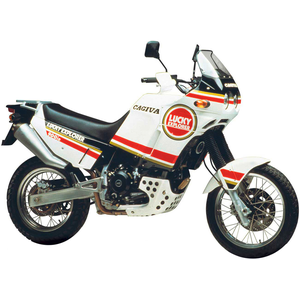Cagiva Elefant 900 (1990-1993): The Desert Legend Revisited
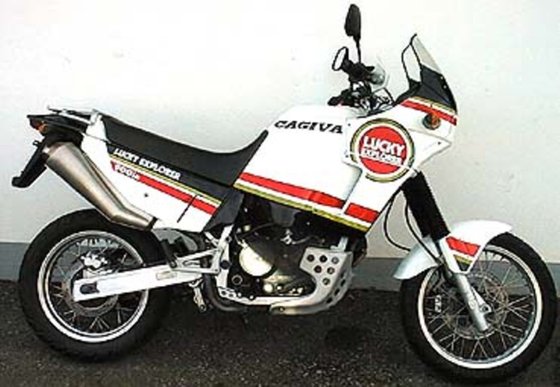
Introduction
The Cagiva Elefant 900 isn’t just a motorcycle—it’s a rolling monument to the golden era of endurance rally racing. Born from Cagiva’s dominance in the Paris-Dakar Rally, this 1990–1993 model generation remains a cult classic among adventure riders and Ducati enthusiasts alike. With its Lucky Strike-inspired livery, burly V-twin heart, and rally-bred DNA, the Elefant 900 is a machine that refuses to fade into obscurity.
This review isn’t a nostalgia trip—it’s a fresh perspective on what made (and still makes) the Elefant 900 a compelling choice for riders who crave versatility, character, and a touch of Italian audacity. Whether you’re navigating city potholes or dreaming of desert horizons, the Elefant demands attention. Let’s dive into why this bike still matters.
Design & Ergonomics: Form Follows Function (Mostly)
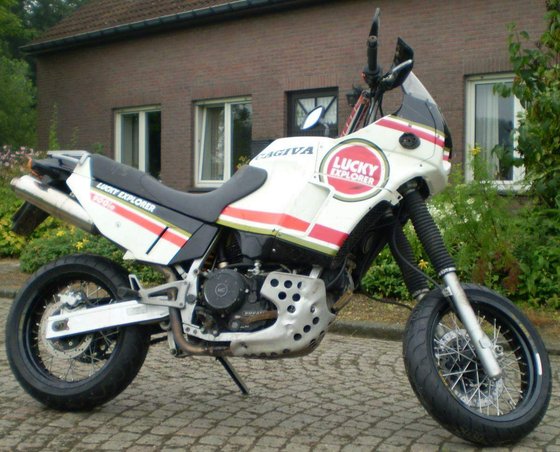
The Elefant 900’s design screams “rally replica,” but with a distinctly Italian flair. The angular fairing, twin headlights, and towering 35.4-inch (900 mm) seat height make it impossible to mistake for anything else. While the Lucky Strike decals evoke its Dakar-winning siblings, the real magic lies in its purposeful details:
- Bodywork: The plastic shrouds aren’t just for show—they protect the air/oil-cooled V-twin from debris while channeling airflow.
- Suspension: Marzocchi forks (42.7mm on early models, 45mm Magnum on GT variants) and an Öhlins monoshock hint at its off-road pedigree.
- Fuel Injection: A Weber-Marelli system—revolutionary for 1990—keeps the engine fed without the fuss of carburetors.
Riding position? Think “commanding.” The wide, flat seat and upright bars cater to long hauls, though shorter riders might struggle at stops. The 24-liter (6.3-gallon) fuel tank sits low, balancing the bike’s 496-pound (225 kg) wet weight. It’s a tall, leggy machine, but once moving, the Elefant feels surprisingly nimble for its size.
Engine & Performance: The Soul of a Ducati, the Stomach of a Camel
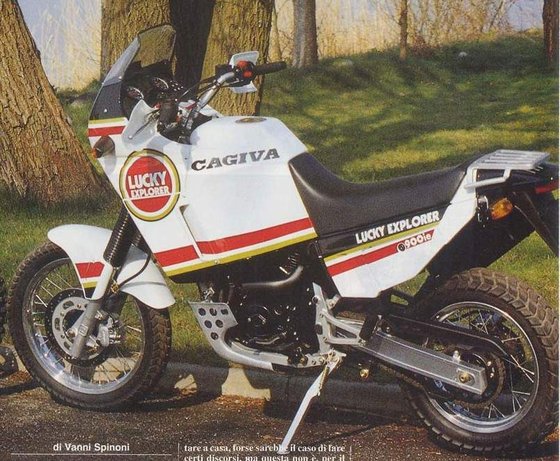
At its core beats a 904cc Desmo V-twin borrowed from the Ducati 900SS, but retuned for endurance. Let’s break down why this engine is legendary:
- Power Delivery: 72 HP (53.6 kW) at 8,000 RPM and 78 Nm (57.5 lb-ft) of torque at 5,250 RPM. Not explosive, but creamy-smooth thanks to fuel injection.
- Desmodromic Valves: No valve float here—the mechanical closure ensures reliability at sustained high revs.
- Gearing: The 5-speed transmission (6-speed on later GT models) is geared for torque, not top speed. Yet, it’ll still hit 113 mph (182 km/h)—enough to outrun most 1990s sportbikes on a dirt road.
On the road, the Elefant pulls like a freight train from 3,000 RPM. The throttle response is linear, avoiding the jerkiness of carbureted rivals. Off-road, the torque-rich low end lets you tractor through sand or mud without fanfare. The dry clutch rattles at stops—a Ducati quirk—but it’s music to a desmo devotee’s ears.
On-Road Manners vs. Off-Road Prowess
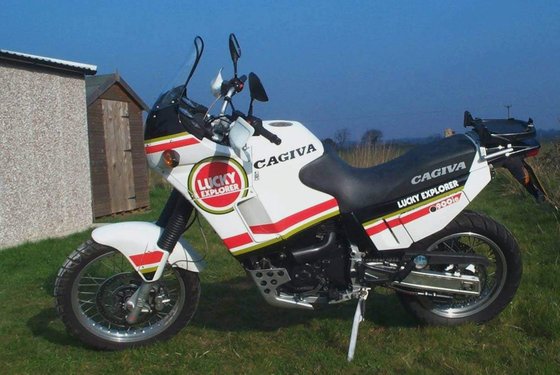
Tarmac Performance
The Elefant defies its dirt-biased looks on pavement. The 19-inch front wheel and 140/80-17 rear tire strike a balance between stability and agility. Lean it into a corner, and the suspension soaks up mid-corner bumps without wallowing. Braking? The single 296mm front disc (Nissin caliper) lacks initial bite but offers progressive feel—perfect for loaded descents.
Dirt Credentials
Switch to a gravel trail, and the Elefant transforms. The long-travel suspension (10.2 inches/260 mm ground clearance) handles ruts and rocks with ease, though the stiff rear spring favors speed over comfort. The 100/90-19 front tire isn’t a true knobby, but it’s enough for light off-roading. Just avoid deep sand—the Elefant’s weight can bury it quickly.
Competition: How the Elefant Stacks Up
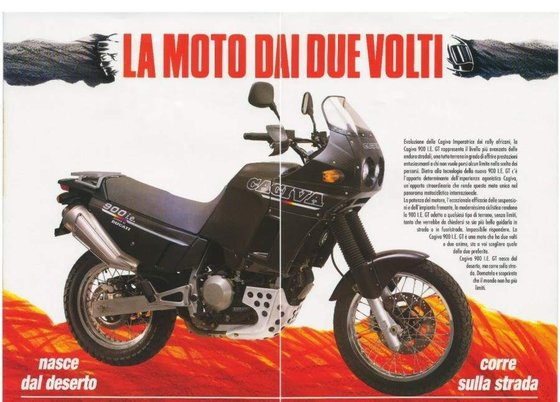
BMW R100GS
- Pros: Shaft drive, bulletproof reputation, lower seat height (33.5 inches).
- Cons: 60 HP air-cooled boxer feels anemic next to the Elefant. Shaft jacking ruins off-road rhythm.
Yamaha Super Ténéré (XTZ750)
- Pros: Lighter, sharper handling, true dual-sport tires.
- Cons: Carbureted engine lacks the Elefant’s refinement. Top speed? A yawn-inducing 105 mph.
Verdict
The Elefant 900 carved a niche by blending Ducati’s sporty DNA with rally toughness. It’s not the best pure roadie or dirt shredder, but as a compromise? Unmatched. The BMW coddles; the Ténéré adventures; the Elefant charges.
Maintenance: Keeping the Legend Alive
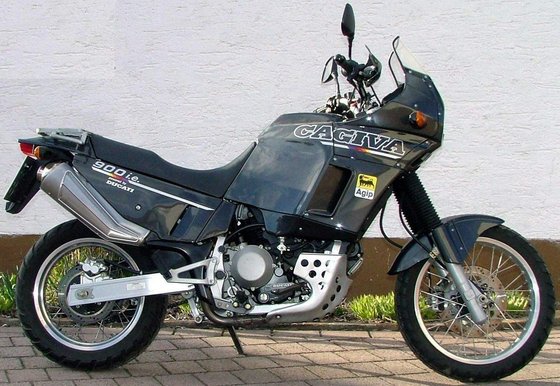
Owning a 30-year-old Italian exotic isn’t for the faint-hearted, but the Elefant rewards those who care for it. Key considerations:
- Desmo Service: Valve adjustments every 6,000 miles (9,656 km). DIY-able with shims, but a shop visit ensures precision.
- Oil Changes: Use 10W-40 or 20W-50 synthetic. The 3.2L capacity needs fresh juice every 3,000 miles.
- Chain & Sprockets: The 108-link chain demands regular cleaning. Upgrade to an X-ring chain for longevity.
- Brake Fluid: Flush DOT 4 every two years—spongy brakes ruin the fun.
- Tire Pressure: 29 PSI (2.0 bar) front / 32 PSI (2.2 bar) rear for road; drop 4-5 PSI off-road.
MOTOPARTS.store Recommendations:
- Öhlins shock rebuild kits for plush damping.
- Brembo brake pads for improved bite.
- Aftermarket exhausts (like Staintune) to unleash the Desmo growl.
Conclusion: The Elephant Never Forgets
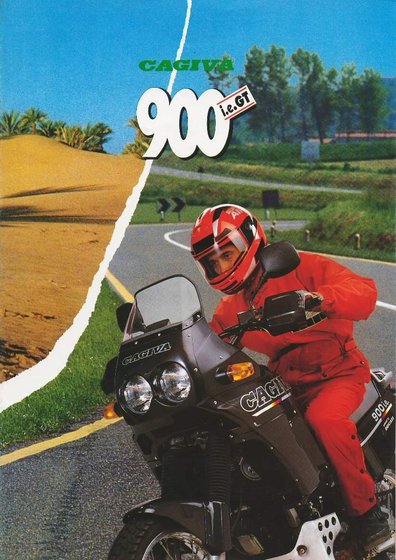
The Cagiva Elefant 900 isn’t a relic—it’s a testament to a time when motorcycles were built with passion, not spreadsheets. Its quirks (hello, thirsty fuel injection) are outweighed by its charisma and versatility. Today, it’s a canvas for restomods, a collector’s trophy, or a trusty companion for riders who value soul over specs.
At MOTOPARTS.store, we’re here to keep your Elefant roaring. Whether you need a clutch rebuild kit or a period-correct decal set, think of us as your pit crew. Now, go dust off that Lucky Strike fairing—adventure awaits.
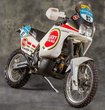


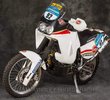













Specifications sheet
| Engine | |
|---|---|
| Stroke: | Four-stroke |
| Max power: | 72 kW | 97.0 hp |
| Max torque: | 78 Nm |
| Fuel system: | Weber L.A.W fuel injection (1990-1992); Mikuni BDST 38 carburetors (1993 AC) |
| Max power @: | 8000 rpm |
| Displacement: | 904 ccm |
| Max torque @: | 5250 rpm |
| Bore x stroke: | 92.0 x 68.0 mm |
| Configuration: | V |
| Cooling system: | Air-cooled |
| Compression ratio: | 9.2:1 |
| Number of cylinders: | 2 |
| Valves per cylinder: | 2 |
| Dimensions | |
|---|---|
| Wheelbase: | 1570 mm (61.8 in) |
| Dry weight: | 189 |
| Wet weight: | 225 |
| Seat height: | 900 mm (35.4 in) (1990-1992); 857 mm (33.7 in) (1993 AC) |
| Ground clearance: | 260 mm (10.2 in) |
| Fuel tank capacity: | 24 L (6.3 US gal) (1990-1992); 22 L (5.8 US gal) (1993 AC) |
| Drivetrain | |
|---|---|
| Final drive: | chain |
| Chain length: | 108 |
| Transmission: | 5-speed (1990-1992), 6-speed (1993 AC/GT) |
| Rear sprocket: | 46 |
| Front sprocket: | 15 |
| Maintenance | |
|---|---|
| Rear tire: | 140/80-17 |
| Engine oil: | 10W40 |
| Front tire: | 100/90-19 |
| Brake fluid: | DOT 4 |
| Spark plugs: | NGK DPR9EA-9 or NGK DPR9EIX-9 |
| Spark plug gap: | 0.9 |
| Coolant capacity: | N/A (Air-cooled) |
| Forks oil capacity: | 0.615 |
| Engine oil capacity: | 3.5 |
| Engine oil change interval: | Every 5000 km or 2 years |
| Valve clearance (intake, cold): | 0.15 mm |
| Valve clearance check interval: | 24,000 km / 15,000 mi |
| Valve clearance (exhaust, cold): | 0.20 mm |
| Recommended tire pressure (rear): | 2.5 bar (36 psi) |
| Recommended tire pressure (front): | 2.25 bar (33 psi) |
| Chassis and Suspension | |
|---|---|
| Frame: | Double steel tubular cradle |
| Rear brakes: | Single 240 mm disc, 4-piston caliper |
| Front brakes: | Single 296 mm disc, 4-piston caliper (1990-1992); Dual 282 mm discs (1993 AC) |
| Rear suspension: | Öhlins monoshock, adjustable preload (1990-1992); Boge hydraulic spring (1993 AC) |
| Front suspension: | 42.7mm Marzocchi telescopic forks (1990-1992); 45mm Showa USD forks (1993 AC) |
| Rear wheel travel: | 290 mm |
| Front wheel travel: | 290 mm |



